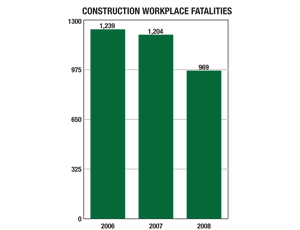The number of construction workplace deaths and the industry’s fatality rate declined in 2008, but construction continues to have the most deaths among all industries, according to the U.S. Labor Dept.’s Bureau of Labor Statistics. BLS also confirms what many knew: 2008 had the most crane accidents in years.
The latest annual BLS Census of Fatal Occupational Injuries, released on Aug. 20, shows construction had 969 fatalities in 2008. It is the largest total among U.S. industries, but the number was down 20% from construction’s 2007 total.
One possible factor contributing to the sharp 2008 downturn in fatalities is last year’s drop in construction activity as the recession took hold. But construction’s 2008 fatality rate, a benchmark that is not affected by the decrease in hours worked, also declined, to 9.6 per 100,000 full-time-equivalent workers, from 10.8 in 2007. Construction’s rate is better than the 29.4 recorded by the agriculture-forestry-fishing-hunting sector and mining’s 18.0, but it is higher than other industries, including manufacturing and utilities.
Industry safety specialists welcome the improvements shown in the BLS figures. Construction’s overall downward trend in deaths and the fatality rate is “very positive,” says Craig A. Shaffer, chairman of the Associated Builders and Contractors’ environment, health and safety committee. But he says the number of deaths is still too high—“It is 969 too many.”
Industry sources suggest various reasons for the progress, including regulatory efforts by the federal Occupational Safety and Health Administration. ABC’s Shaffer also cites “an awful lot of voluntary activities” by construction companies to improve jobsite safety. He says such efforts are “good business, from the moral standpoint and from the business-survival standpoint. [Firms with] great safety programs are successful companies, and people want to work there.”
Kevin Cannon, the Associated General Contractors’ director of safety and health services, says some improvements “can be attributed to a collaborative approach between the industry and OSHA.” He cites the Voluntary Protection Programs, Safety and Health Achievement Recognition Program and Construction Health and Safety Excellence as examples.
“We are happy to see the decline in construction fatalities,” says Xiuwen “Sue” Dong, data-center director for CPWR—The Center for Construction Research and Training, an affiliate of the AFL-CIO’s Building and Construction Trades Dept. But Dong also suggests the decrease in the number of fatalities could stem from “the downturn in the overall construction industry and employment and fewer workers in the high-risk population in this industry.” She says CPWR research shows the number of Hispanic construction workers declined 17% between 2007 and 2008, and they “have a higher fatality rate than their non-Hispanic counterparts.”
The 2008 fatality totals for crane accidents are worrisome. In slightly more than three months last year, tower-crane accidents rocked New York City twice and Miami once, leading to the 11 deaths of workers or civilians, while other accidents involving mobile cranes persisted.
Total crane-related fatalities recorded for all industries skyrocketed more than 37% in 2008, according to BLS. The lowest annual deaths for the 2003-2008 period were the 62 fatalities recorded in 2003. Likewise, crane deaths that BLS pegged as taking place on a construction project spiked nearly 42%, to 51.
“It cries out for more protective training and certification,” says Graham Brent, executive director of the National Commission for the Certification of Crane Operators (NCCCO), Fairfax, Va. “The more states that adopt mandatory certification and the more employers that adopt it, the better off we will be,” he says. At present, 17 states and six cities require operators to carry such proof of training, NCCCO says.
Last year’s crane accidents exposed industry problems beyond the scope of operators, and initiatives are under way to address them. NCCCO has tested candidates in more than 20 states seeking certification for a new signalperson program, launched last October, and a new rigger program, begun in April. A crane-inspector module also is in the works.
Industry and union officials are anxiously awaiting the final version of a new federal crane-and-derrick safety standard from the Occupational Safety and Health Administration. Officials have been poring over several hundred comments they received concerning OSHA’s proposed revision. Among the proposal’s most controversial elements is a requirement for operator certification. As proposed, the regulation would not require signalpersons, riggers or inspectors to be certified.
OSHA’s new crane standards have been in the works for years, but the end is near. “We are confident that we will issue a final rule next year,” says Richard De Angelis, an OSHA spokesman.
Though the BLS data suggest crane work was less safe last year, the statistics may not be accurate. Accident reports filled out by OSHA inspectors often label construction-related fatalities as non-construction and record crane-related deaths as non-crane, experts say.
Across all industries, total fatal workplace injuries in 2008 were down 10%, to 5,071. That is the lowest annual preliminary mark since BLS began its census in 1992. The fatal-injury rate also declined, to 3.6 from 4.0.




Post a comment to this article
Report Abusive Comment